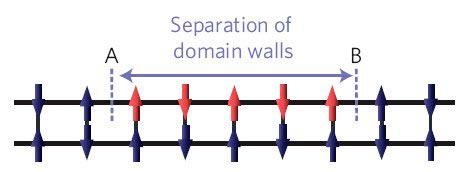
Particle-like entities in a magnetic crystal are confined to form composite particles just as quarks are bound together within protons and neutrons – according to experiments done by physicists in Germany and the UK. The ability to observe spinon confinement within a controllable condensed-matter system could improve our current qualitative understanding of quark confinement in particle physics.
According to the theory of quantum chromodynamics (QCD), quarks are held together by the strong force. This force gets stronger with increasing distance, meaning that quarks cannot be pulled apart but are “confined” within composite particles such as protons and neutrons – which consist of three quarks – and mesons, which consist of two quarks.
Confinement means that quarks can never be observed individually and their properties can therefore only be studied indirectly. However, in 1996 Alexei Tsvelik, Alexander Nersesyan and David Shelton predicted confinement in certain easier-to-study condensed matter systems known as spin ladders consisting of two chains of copper oxide chemically bonded together. In each chain electrons should behave collectively so that the aggregate charge and spin separate out to form entities not tied to particular electrons. Tsvelik and colleagues argued that the spin entities – called spinons – would be analogous to quarks and would be confined when two chains are brought together to form a ladder.
Inelastic scattering
That idea has now been demonstrated experimentally by Bella Lake of the Helmholtz-Zentrum in Berlin and colleagues. Lake’s team used the ISIS neutron source at Rutherford Appleton Laboratory in the UK to scatter neutrons with a known energy off magnetic crystals of the copper-oxide compound calcium cuprate. By measuring the energies and scattering angles of the emerging neutrons the researchers were able to calculate the energy and momentum taken up by the sample. This in turn revealed information about the magnetic state of the crystals. They found that at high neutron energies the crystals behaved like individual chains with free spinons, whereas at low energies the interchain coupling within the ladders binds the spinons together (this is not the only condensed-matter system that, according to theory, should display confinement but it is the only one so far to have been realized experimentally).
The researchers say that ladders lead to confinement because within a single chain the spins between two spinons point in the opposite direction to that in which they would point were there no spinons. When this chain is coupled antiferromagnetically to another chain these reversed spins take up energy because they line up in parallel with the spins on the neighbouring chain (i.e. they go against the antiferromagnetic grain).
As the distance between spinons increases the number of spins aligned parallel to one another increases, rendering the arrangement ever less energetically favourable and so confining the spinons. Each spinon carries the quantum number spin-1/2, meaning that a pair of spinons has integer spin, just as quarks, which each carry a fractional charge, combine to form particles with integer charge.
Shedding light on QCD
This research could also shed some light on QCD. The mathematics underpinning QCD make it impossible to precisely calculate analytically the values of the various fundamental properties of both quarks and the particles that they make up. For example, physicists have struggled to calculate the mass of the proton – a value that is known to great precision experimentally – using numerical techniques. Tsvelik, now at the Brookhaven National Laboratory in the US, says that being able to calculate the properties of spinons analytically and then compare these calculations with experiment should tell us more about confinement in general and could therefore provide some hints about the nature of quark confinement. But he cautions that the comparison cannot be taken too far.
Frank Wilczek of the Massachusetts Institute of Technology in the US, who shared the Nobel prize for his work on the strong force, welcomes this experimental demonstration of confinement pointing out that condensed-matter systems are “interesting in their own right, and much easier to work with” than systems of fundamental particles. However, like Tsvelik he believes that the approach has its limitations. “The mechanisms of confinement in particle physics are significantly different from those in one-dimensional systems,” he says. “So I don’t think those simpler systems can in any real sense provide analogue computers for the harder problems; rather, they can be a source of inspiration and a testbed for ideas.”
The research is published online in the journal Nature Physics.



